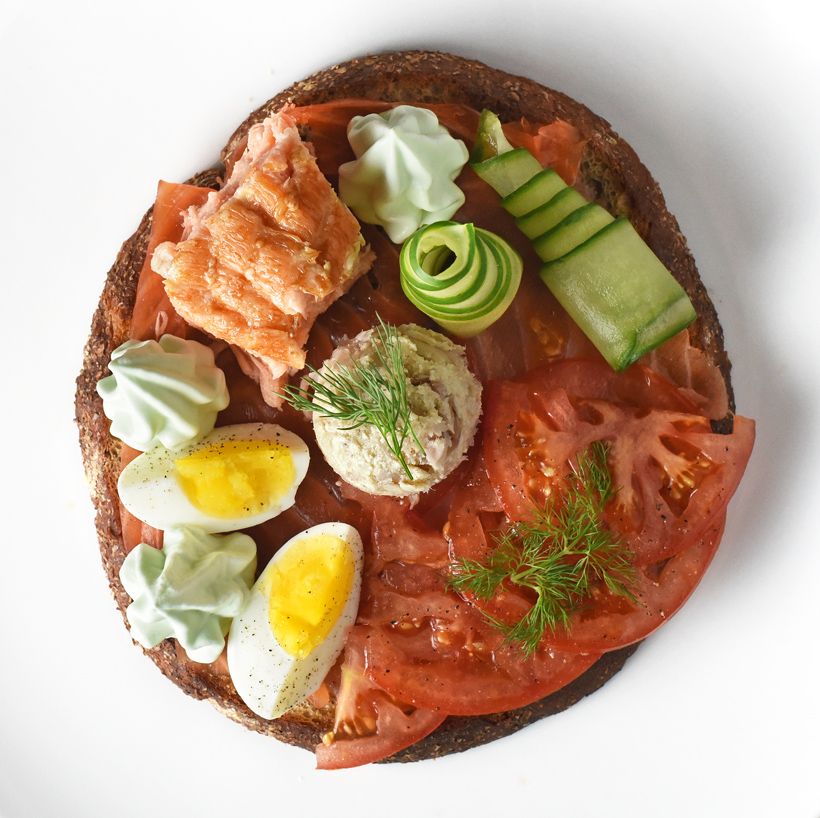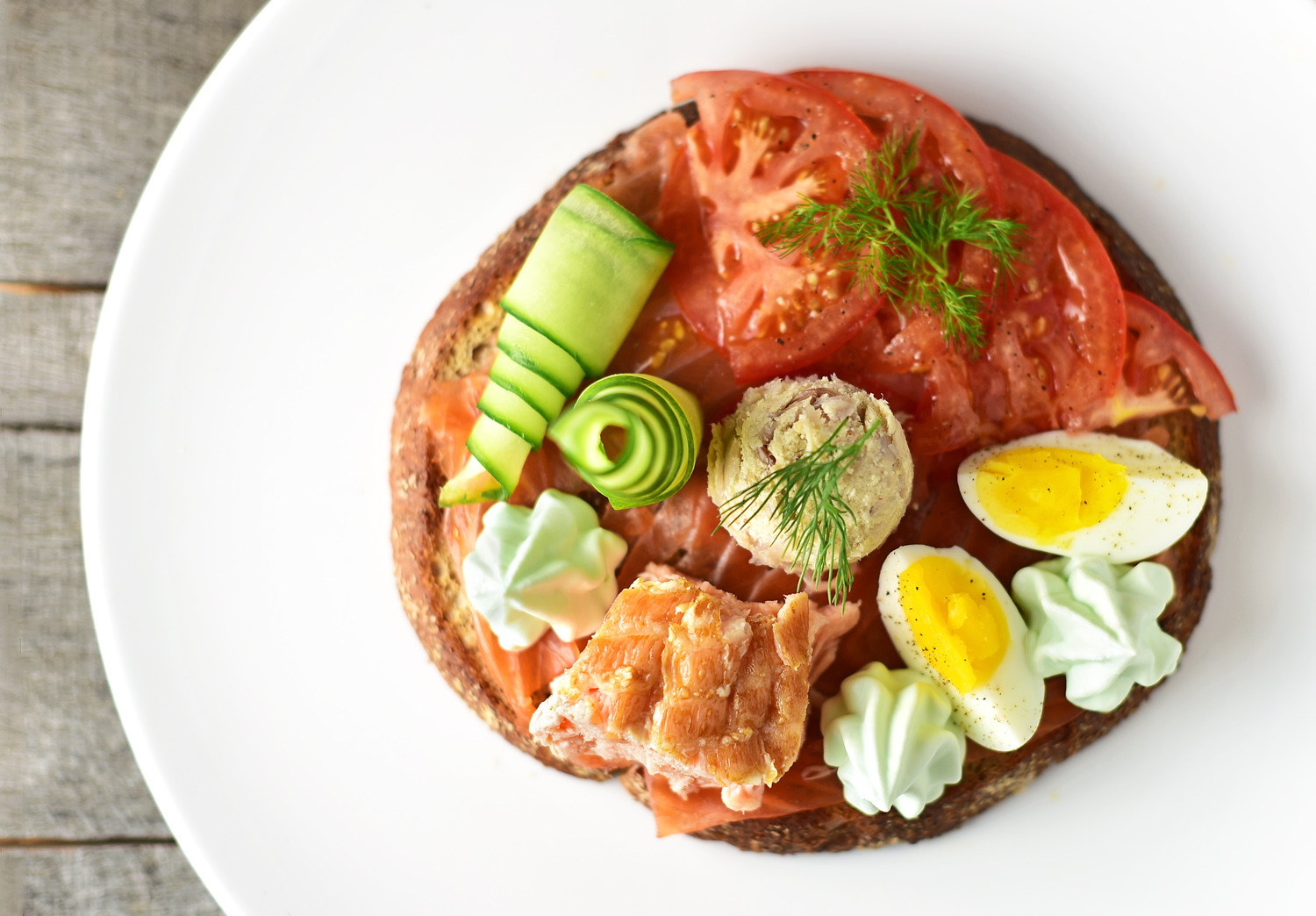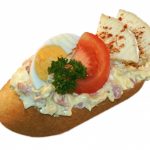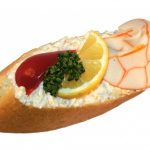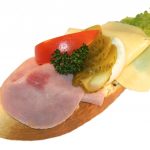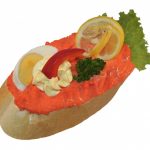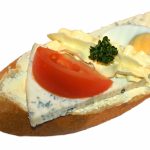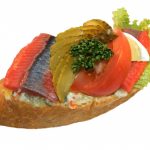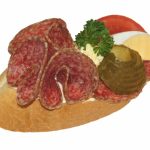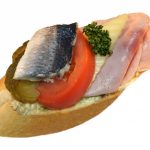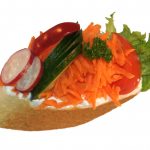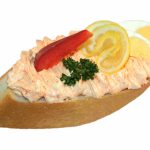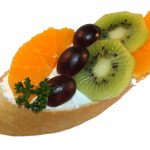In Czech Republic, a chlebíček is just an open-faced sandwich. More often than not, what you’ll see is whole plates of assorted obložené chlebíčky (literally, garnished little breads), which give amateur cooks the opportunity to showcase their aesthetic leanings on little slices of bread, with complete disregard for practicality. Cured meat, cured fish, cheese, vegetables, herbs, pickles, egg, dressing, or even fruit… There’s nothing that can’t find its place on a chlebíček. And since the goal is to impress, the more the merrier! The only rule is that these ingredients are never arranged in a sensible way for a sandwich — judge for yourself (images from the Golden Cross Deli in Prague):
To be fair, the concept goes way beyond Czech Republic. Russians are fond of their buterbrod, Scandinavians have their smørbrød, and the Finns, their voileipä. Back in the Middle Ages, the bread of these open-faced sandwiches served as a plate, and was eaten at the end of the meal. Later on, the bread slice was spread with butter and topped with fish or meat (which is why many of the words for open sandwiches actually translate as buttered bread). More recently, in Eastern Europe, these toasts have taken on a decidedly kitsch appearance, as you can see.
Before I start talking about my own eccentric rendition, let’s see how a real Czech native does it. Ladies and gentlemen, the Martha Stewart of chlebíčky:
OK, well, my recipe’s got little in common with that:
- First, I’m making a giant chlebíček, cutting a whole loaf of bread lengthwise. It actually makes a lot of sense to supersize this whimsical toast, as you have a lot more space upon which to redistribute the ingredients to your liking. Since nobody expects you to eat it with your hands anymore, you’ve got silverware to help you. This is also closer to the original idea of a bread slice as a plate.
- The bounty I brought back from my last fishing trip gave me a chance to redo many of my favorite trout and salmon recipes: the lake trout rillettes, vodka-cured lake trout, and kippered salmon. All of them fit beautifully on the giant chlebíček and create an interesting range of textures for the same ingredient (i.e., the salmonid). Of course, you could just as well make or buy cured salmon, salmon rillettes, and kippered trout.
- On account of my recent absinthe obsession, I’ve also been wanting to cook something with absinthe. Absinthe mayonnaise? In my experiments, the absinthe broke the mayo’s emulsion. Absinthe whipped cream? The absinthe’s too overpowering. Absinthe gravlax sauce? I’ve seen absinthe mustard in stores, but the gravlax sauce would just look like a puddle once poured onto the bread. I settled on a mixture of ricotta (or cottage cheese), absinthe, mustard, lemon juice, and sugar, which has just the right texture to be piped into rosettes. If you want to recreate the vibrant green color of certain Czech absinthes, add some food coloring!
- The rest is classic chlebíček: tomato, cucumber, hard-boiled egg, and dill. Still, with no pickles, ham, or cheese, this ends up being a rather unique combination…
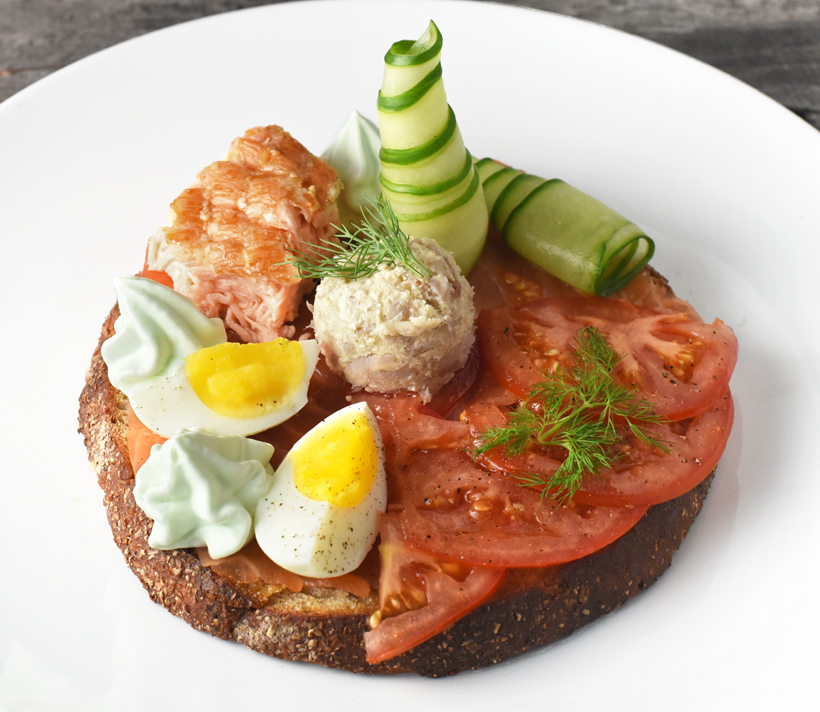
Absinthe cream
Yields about 4 servings
5 g Saint-Antoine absinthe
2 drops green food coloring (optional)
20 g lemon juice
10 g Dijon mustard
5 g sugar
170 g ricotta or cottage cheese
salt
- In a bowl, mix the absinthe, food coloring, lemon juice, mustard, and sugar.
- Add the ricotta, season with salt, and combine until homogenous. Refrigerate for at least 1 hour.
Assembly
Yields 4 servings
1 or 2 round bread loaves, 16-18 cm diameter (see below)
60 g butter
2 large tomatoes (about 7.5 cm diameter, 350 g total)
olive oil
salt
black pepper, ground
1 cucumber (about 25 cm long, 350-400 g)
2 hard-boiled eggs
absinthe cream
250-300 g (about 3/4 recipe) vodka-cured lake trout (or your favorite cured or smoked salmon), thinly sliced
250-300 g (about 1/3 recipe) kippered salmon (or kippered trout), cut into 4 pieces
125-150 g (about 1/8 recipe) lake trout rillettes (or salmon rillettes)
8 sprigs dill
- Note that all the ingredient amounts given here are approximate, as what really matters isn’t the exact weight, but whether the various elements cover the chlebíček harmoniously.
- Cut the bread “lengthwise” to make 4 giant round slices that are about 1 cm thick and 16-18 cm across. Depending on the size of the loaves, you will need 1 or 2 of them. The exact type of bread you choose is up to you: white, whole wheat, sourdough, rye…
- Heat a non-stick pan over medium heat. Proceeding in batches, toast the bread slices in butter until golden on both sides. Reserve.
- Cut the tomatoes into 20 thin slices (about 3 mm thick). Drizzle with a little bit of olive oil, and season with salt and pepper.
- Cut the cucumber in half lengthwise. Using a Y-shaped peeler, cut 8 long, thin strips. Season with salt, and roll each strip into a cone.
- Cut the hard-boiled eggs into quarters, and season with salt and pepper.
- Place the absinthe cream in a piping bag fit with a decorative tip.
- Please each bread slice on a large round plate. Cover with cured trout (the exact amount depends on the thickness of the fish slices). Place a 3.75 cm diameter scoop of trout rillettes in the center. Garnish each quadrant as follows: about 5 tomato slices, 2 egg quarters, a piece of kippered salmon, and 2 cucumber cones. Pipe 3 rosettes of absinthe cream in the gaps left by the other garnishes, and decorate with a couple sprigs of dill.
